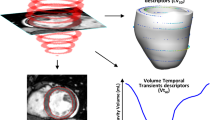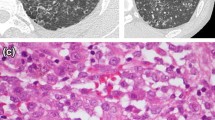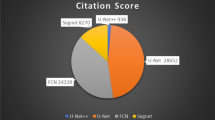Abstract
Purpose
(1) To improve the accuracy of global and regional alveolar-recruitment quantification in CT scan pairs by accounting for lung-tissue displacements and deformation, (2) To propose a method for local-recruitment calculation.
Methods
Recruitment was calculated by subtracting the quantity of non-aerated lung tissues between expiration and inspiration. To assess global recruitment, lung boundaries were first interactively delineated at inspiration, and then they were warped based on automatic image registration to define the boundaries at expiration. To calculate regional recruitment, the lung mask defined at inspiration was cut into pieces, and these were also warped to encompass the same tissues at expiration. Local-recruitment map was calculated as follows: For each voxel at expiration, the matching location at inspiration was determined by image registration, non-aerated voxels were counted in the neighborhood of the respective locations, and the voxel count difference was normalized by the neighborhood size. The methods were evaluated on 120 image pairs of 12 pigs with experimental acute respiratory distress syndrome.
Results
The dispersion of global- and regional-recruitment values decreased when using image registration, compared to the conventional approach neglecting tissue motion. Local-recruitment maps overlaid onto the original images were visually consistent, and the sum of these values over the whole lungs was very close to the global-recruitment estimate, except four outliers.
Conclusions
Image registration can compensate lung-tissue displacements and deformation, thus improving the quantification of alveolar recruitment. Local-recruitment calculation can also benefit from image registration, and its values can be overlaid onto the original image to display a local-recruitment map. They also can be integrated over arbitrarily shaped regions to assess regional or global recruitment.



Similar content being viewed by others
References
Caironi P, Cressoni M, Chiumello D, Ranieri M, Quintel M, Russo SG, Cornejo R, Bugedo G, Carlesso E, Russo R, Caspani L, Gattinoni L (2010) Lung opening and closing during ventilation of acute respiratory distress syndrome. Am J Respir Crit Care Med 181(6):578–586. https://doi.org/10.1164/rccm.200905-0787OC
Crotti S, Mascheroni D, Caironi P, Pelosi P, Ronzoni G, Mondino M, Marini JJ, Gattinoni L (2001) Recruitment and derecruitment during acute respiratory failure. Am J Respir Crit Care Med 164(1):131–140. https://doi.org/10.1164/ajrccm.164.1.2007011
Fanelli V, Vlachou A, Ghannadian S, Simonetti U, Slutsky AS, Zhang H (2013) Acute respiratory distress syndrome: new definition, current and future therapeutic options. J Thorac Dis 5(3):326–334. https://doi.org/10.3978/j.issn.2072-1439.2013.04.05
Gattinoni L, Caironi P, Cressoni M, Chiumello D, Ranieri VM, Quintel M, Russo S, Patroniti N, Cornejo R, Bugedo G (2006) Lung recruitment in patients with the acute respiratory distress syndrome. N Engl J Med 354(17):1775–1786. https://doi.org/10.1056/NEJMoa052052
Gattinoni L, Pelosi P, Crotti S, Valenza F (1995) Effects of positive end-expiratory pressure on regional distribution of tidal volume and recruitment in adult respiratory distress syndrome. Am J Respir Crit Care Med 151(6):1807–1814. https://doi.org/10.1164/ajrccm.151.6.7767524
Klein S, Staring M, Murphy K, Viergever M, Pluim J (2010) elastix: a toolbox for intensity-based medical image registration. IEEE Trans Med Imaging 29(1):196–205
Malbouisson LM, Muller JC, Constantin JM, Lu Q, Puybasset L, Rouby JJ, the CT Scan ARDS Study Group (2001) Computed tomography assessment of positive end-expiratory pressure-induced alveolar recruitment in patients with acute respiratory distress syndrome. Am J Respir Crit Care Med 163(6):1444–1450. https://doi.org/10.1164/ajrccm.163.6.2005001
Morales Pinzón A, Orkisz M, Richard JC, Hernández Hoyos M (2017) Lung segmentation by cascade registration. IRBM 38:266–280. https://doi.org/10.1016/j.irbm.2017.07.003
Nieman GF, Satalin J, Andrews P, Aiash H, Habashi NM, Gatto LA (2017) Personalizing mechanical ventilation according to physiologic parameters to stabilize alveoli and minimize ventilator induced lung injury (VILI). Intensive Care Med Exp 5(1):8. https://doi.org/10.1186/s40635-017-0121-x
Pelosi P, Goldner M, McKibben A, Adams A, Eccher G, Caironi P, Losappio S, Gattinoni L, Marini JJ (2001) Recruitment and derecruitment during acute respiratory failure: an experimental study. Am J Respir Crit Care Med 164:122–130. https://doi.org/10.1164/ajrccm.164.1.2007010
Richard JC, Pouzot C, Morales Pinzón A, Torres González JS, Orkisz M, Neyran B, Hernández Hoyos M, Lavenne F, Guérin C (2014) Reliability of the nitrogen washin-washout technique to assess end-expiratory lung volume at variable PEEP and tidal volumes. Intensive Care Med Exp 2(1):10. https://doi.org/10.1186/2197-425X-2-10
Shamonin DP, Bron EE, Lelieveldt BP, Smits M, Klein S, Staring M (2014) Fast parallel image registration on CPU and GPU for diagnostic classification of Alzheimer’s disease. Front Neuroinform 7(50):1–15
Top A, Hamarneh G, Abugharbieh R (2010) Spotlight: automated confidence-based user guidance for increasing efficiency in interactive 3D image segmentation. In: Menze B, Langs G, Tu Z, Criminisi A (eds) Medical computer vision. Recognition techniques and applications in medical imaging, vol 6533. Lecture notes in computer science. Springer, Berlin, pp 204–213. https://doi.org/10.1007/978-3-642-18421-5_20
Top A, Hamarneh G, Abugharbieh R (2011) Active learning for interactive 3D image segmentation. In: Fichtinger G, Martel A, Peters T (eds) Medical image computing and computer-assisted intervention (MICCAI), vol 6893. Lecture notes in computer science. Springer, Berlin, pp 603–610. https://doi.org/10.1007/978-3-642-23626-6_74
Vieira SRR, Puybasset L, Richecoeur J, Lu Q, Cluzel P, Gusman PB, Rouby Coriat PJJ (1998) A lung computed tomographic assessment of positive end-expiratory pressure-induced lung overdistention. Am J Respir Crit Care Med 158(5):1571–1577. https://doi.org/10.1164/ajrccm.158.5.9802101
Xin Y, Song G, Cereda M, Kadlecek S, Hamedani H, Jiang Y, Rajaei J, Clapp J, Profka H, Meeder N, Wu J, Tustison NJ, Gee JC, Rizi RR (2015) Semiautomatic segmentation of longitudinal computed tomography images in a rat model of lung injury by surfactant depletion. J Appl Physiol 118(3):377–385. https://doi.org/10.1152/japplphysiol.00627.2014
Author information
Authors and Affiliations
Corresponding author
Ethics declarations
Conflict of interest
The authors declare that they have no conflict of interest.
Ethical approval
This study was approved by our Institutional Review Board for the care of animal subjects (Comité d’Expérimentation Animale de l’Université Lyon 1). All procedures performed in studies involving animals were in accordance with the ethical standards of the institution at which the studies were conducted. All applicable international, national, and/or institutional guidelines for the care and use of animals were followed.
Additional information
Publisher's Note
Springer Nature remains neutral with regard to jurisdictional claims in published maps and institutional affiliations.
This work was performed within the framework of the LABEX PRIMES (ANR-11-LABX-0063) of Université de Lyon within the program “Investissements d’Avenir” (ANR-11-IDEX-0007) and supported by the French-Colombian program ECOS-Nord, project C15M04.
Electronic supplementary material
Below is the link to the electronic supplementary material.
Supplementary material 2 (mp4 12130 KB)
Supplementary material 3 (mp4 5658 KB)
Rights and permissions
About this article
Cite this article
Orkisz, M., Morales Pinzón, A., Richard, JC. et al. Voxel-wise assessment of lung aeration changes on CT images using image registration: application to acute respiratory distress syndrome (ARDS). Int J CARS 14, 1945–1953 (2019). https://doi.org/10.1007/s11548-019-02064-3
Received:
Accepted:
Published:
Issue Date:
DOI: https://doi.org/10.1007/s11548-019-02064-3




